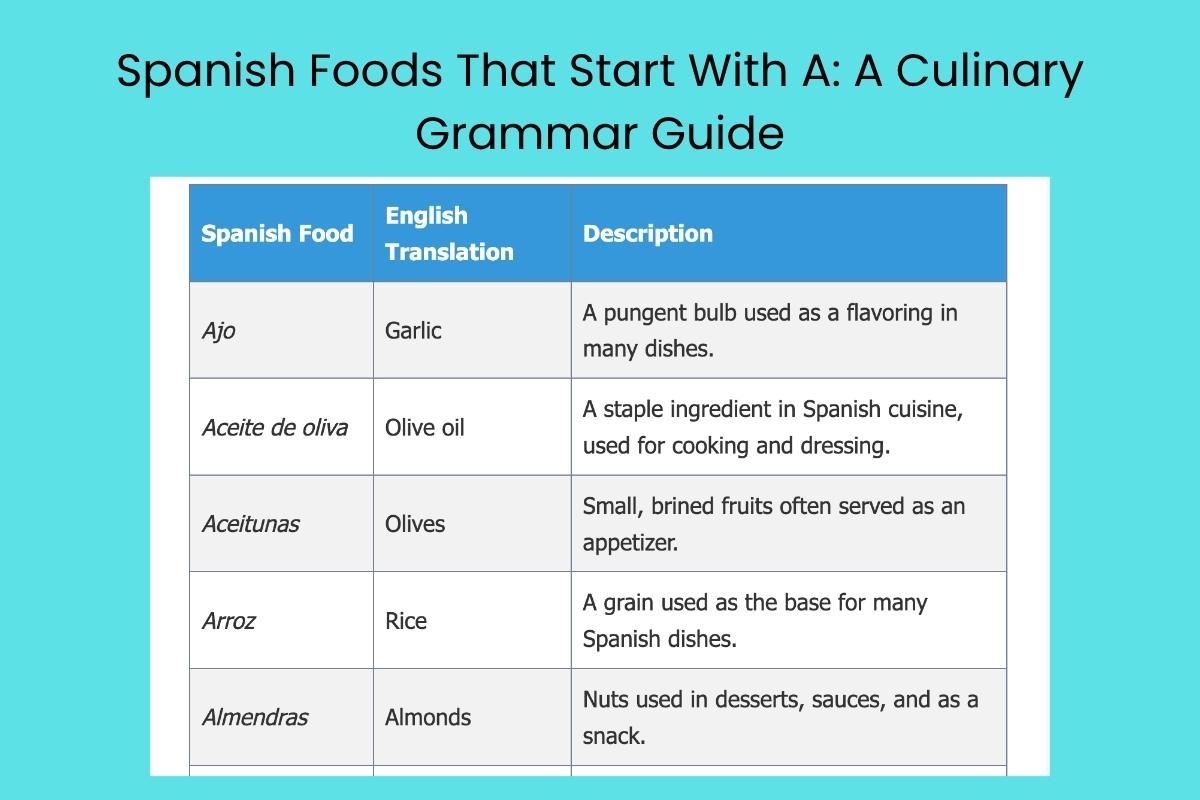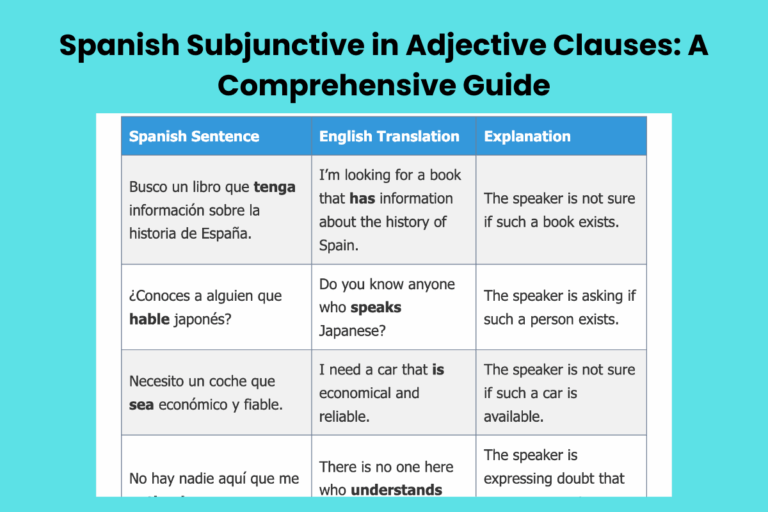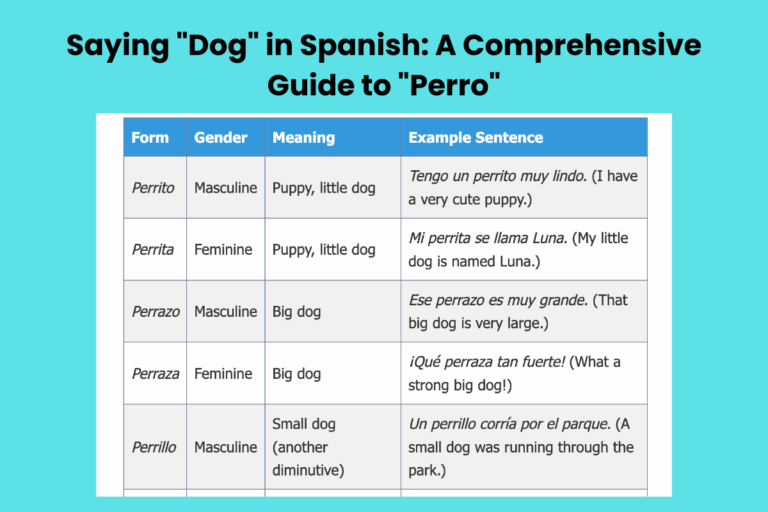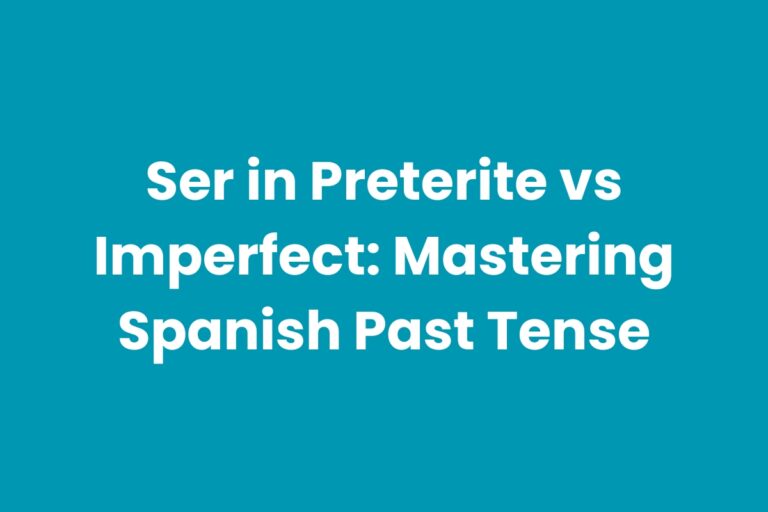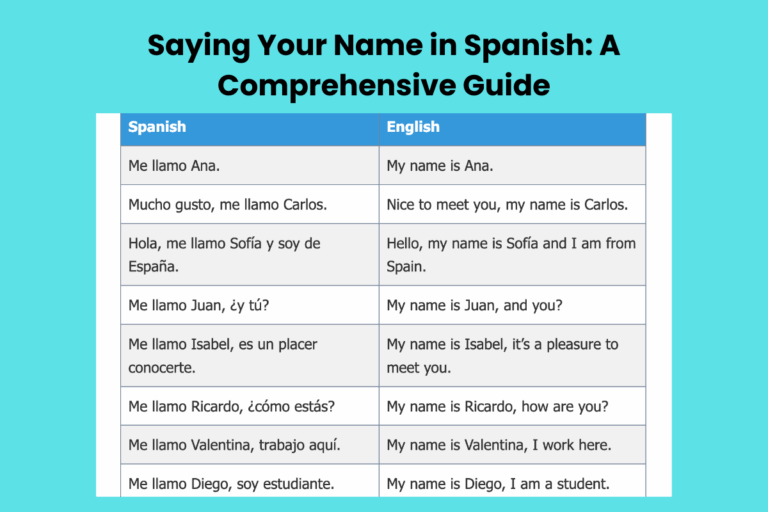Spanish Foods That Start With A: A Culinary Grammar Guide
Embarking on a culinary journey through Spanish cuisine is not just about tasting delicious dishes; it’s also an opportunity to enrich your understanding of the Spanish language and its grammar. Foods that start with the letter “A” in Spanish offer a fantastic gateway to explore nouns, articles, and adjectives, all while whetting your appetite.
This guide will provide a structured approach to learning Spanish grammar through the lens of “A” foods, making it both educational and delicious. Whether you’re a beginner or an advanced learner, this exploration will enhance your linguistic skills and cultural appreciation.
Table of Contents
- Introduction
- Definition: Spanish Food Vocabulary and Grammar
- Structural Breakdown: Nouns, Articles, and Adjectives
- Categories of “A” Foods in Spanish
- Examples: Spanish Foods Starting with “A”
- Usage Rules: Applying Grammar to Food Vocabulary
- Common Mistakes: Avoiding Errors in Food-Related Spanish
- Practice Exercises
- Advanced Topics: Nuances in Food Terminology
- FAQ: Frequently Asked Questions
- Conclusion
Introduction
The Spanish language, rich in culture and history, offers a diverse landscape of culinary terms, particularly those that begin with the letter “A.” Exploring these food-related words provides a unique opportunity to delve into the nuances of Spanish grammar. By focusing on nouns, articles, and adjectives associated with these foods, learners can enhance their linguistic skills in a practical and engaging way.
This article is designed to be a comprehensive guide, suitable for both beginners and advanced Spanish students, aiming to solidify their understanding of essential grammar concepts through the delicious world of Spanish cuisine.
Understanding how to describe and discuss food in Spanish is crucial for effective communication, whether you’re ordering at a restaurant, sharing recipes, or simply engaging in conversation. This guide will break down the grammar rules and vocabulary associated with Spanish foods starting with “A,” providing clear explanations, examples, and practice exercises.
By the end of this article, you’ll not only expand your knowledge of Spanish cuisine but also improve your grasp of fundamental grammatical structures.
Definition: Spanish Food Vocabulary and Grammar
Spanish food vocabulary refers to the collection of words used to describe various dishes, ingredients, and culinary preparations in the Spanish language. This vocabulary encompasses nouns (names of foods), verbs (cooking actions), adjectives (describing flavors or textures), and adverbs (modifying how something is cooked or eaten).
Understanding this vocabulary is essential for anyone interested in Spanish cuisine or culture. Spanish grammar, on the other hand, provides the rules for organizing and using these words correctly in sentences.
It includes elements like noun-article agreement, adjective placement, and verb conjugations.
In the context of Spanish foods starting with “A,” grammar plays a crucial role in ensuring accurate and meaningful communication. For example, the correct use of articles (el, la, los, las) is essential when referring to specific foods. Similarly, adjectives must agree in gender and number with the nouns they modify. Mastering these grammatical concepts will enable you to describe and discuss Spanish foods with confidence and precision.
Nouns
Nouns are words that represent people, places, things, or ideas. In the context of Spanish food, nouns refer to the names of different dishes, ingredients, and utensils. For example, ajo (garlic) and aceite (oil) are common nouns in Spanish cuisine. Nouns in Spanish have gender (masculine or feminine) and number (singular or plural), which affect the articles and adjectives that accompany them.
Articles
Articles are words that precede nouns to specify whether they are definite (specific) or indefinite (general). In Spanish, the definite articles are el (masculine singular), la (feminine singular), los (masculine plural), and *las* (feminine plural). The indefinite articles are *un* (masculine singular), *una* (feminine singular), *unos* (masculine plural), and *unas* (feminine plural). For example, el ajo (the garlic) and una aceituna (an olive).
Adjectives
Adjectives are words that describe nouns, providing more information about their qualities or characteristics. In Spanish, adjectives typically follow the noun they modify and must agree in gender and number. For example, ajo picante (spicy garlic) and aceitunas verdes (green olives). The correct use of adjectives is crucial for accurately describing the flavors, textures, and appearances of Spanish foods.
Structural Breakdown: Nouns, Articles, and Adjectives
Understanding the structural elements of Spanish grammar is essential for constructing accurate and meaningful sentences about food. This section will break down the roles of nouns, articles, and adjectives and how they interact with each other.
Noun-Article Agreement: In Spanish, articles must agree in gender and number with the nouns they modify. This means that if a noun is masculine singular, it must be preceded by the masculine singular article el or un. Similarly, if a noun is feminine plural, it must be preceded by the feminine plural article las or unas. For example:
- El arroz (the rice) – masculine singular
- La aceituna (the olive) – feminine singular
- Los ajos (the garlics) – masculine plural
- Las almendras (the almonds) – feminine plural
Noun-Adjective Agreement: Adjectives in Spanish must also agree in gender and number with the nouns they modify. This means that the ending of the adjective must change to match the gender and number of the noun. For example:
- Ajo blanco (white garlic) – masculine singular
- Aceituna verde (green olive) – feminine singular
- Ajos picantes (spicy garlics) – masculine plural
- Almendras saladas (salty almonds) – feminine plural
Adjective Placement: In Spanish, adjectives typically follow the noun they modify. However, certain adjectives, such as those indicating quantity or order, may precede the noun. For example:
- Un plato abundante (an abundant dish)
- Primer aperitivo (first appetizer)
Categories of “A” Foods in Spanish
Spanish foods that start with the letter “A” can be categorized in various ways, such as by main ingredient, type of dish, or region of origin. This section will explore some of these categories to provide a comprehensive overview of “A” foods in Spanish cuisine.
Main Ingredients
Some “A” foods are primarily defined by their main ingredient, which starts with the letter “A.” Examples include:
- Ajo (Garlic): Used in countless Spanish dishes for its pungent flavor.
- Aceite de oliva (Olive Oil): A staple ingredient in Mediterranean cuisine, including Spanish.
- Aceitunas (Olives): Eaten as appetizers or used as ingredients in various dishes.
- Arroz (Rice): The base for many popular Spanish dishes like paella.
- Almendras (Almonds): Used in desserts, sauces, and as a snack.
Types of Dishes
Other “A” foods are classified by the type of dish they represent, such as appetizers, main courses, or desserts. Examples include:
- Aperitivos (Appetizers): Small dishes served before a meal, often including olives, almonds, or garlic-based snacks.
- Arroces (Rice Dishes): A category of dishes based on rice, like paella.
- Albóndigas (Meatballs): Often served in tomato sauce.
- Ajo Blanco (White Garlic Soup): A cold soup made with garlic, almonds, and bread.
Regional Origin
Many Spanish dishes are associated with specific regions, reflecting the local ingredients and culinary traditions. Examples include:
- Arroz a la Zamorana (Rice from Zamora): A rice dish from the Zamora region.
- Ajoarriero: A dish made with cod, potatoes, and garlic, popular in various regions.
Examples: Spanish Foods Starting with “A”
This section provides extensive examples of Spanish foods that start with the letter “A,” along with their descriptions and grammatical usage. Each example includes the Spanish name of the food, its English translation, and a brief description.
Here’s a table showcasing various Spanish foods starting with the letter “A,” their English translations, and descriptions:
| Spanish Food | English Translation | Description |
|---|---|---|
| Ajo | Garlic | A pungent bulb used as a flavoring in many dishes. |
| Aceite de oliva | Olive oil | A staple ingredient in Spanish cuisine, used for cooking and dressing. |
| Aceitunas | Olives | Small, brined fruits often served as an appetizer. |
| Arroz | Rice | A grain used as the base for many Spanish dishes. |
| Almendras | Almonds | Nuts used in desserts, sauces, and as a snack. |
| Azafrán | Saffron | An expensive spice used to flavor and color dishes. |
| Alcachofas | Artichokes | A vegetable often grilled, fried, or used in stews. |
| Aguacate | Avocado | Though not traditionally Spanish, it’s increasingly popular. |
| Anchoas | Anchovies | Small, salty fish often served as tapas. |
| Aperitivos | Appetizers | Small dishes served before a meal. |
| Arroces | Rice dishes | A category of dishes based on rice, like paella. |
| Albóndigas | Meatballs | Often served in tomato sauce. |
| Ajo Blanco | White Garlic Soup | A cold soup made with garlic, almonds, and bread. |
| Arroz a la Zamorana | Rice from Zamora | A rice dish from the Zamora region. |
| Ajoarriero | Garlic Muleteer | A dish made with cod, potatoes, and garlic. |
| Alioli | Garlic and Oil Sauce | A sauce made from garlic and oil, similar to aioli. |
| Alubias | Beans | A type of legume often used in stews. |
| Angulas | Baby Eels | A delicacy, often cooked with garlic and chili. |
| Arándanos | Blueberries | Used in desserts and increasingly in salads. |
| Aceite de girasol | Sunflower oil | A common cooking oil. |
| Albaricoque | Apricot | A stone fruit eaten fresh or used in desserts. |
| Apio | Celery | Used as a vegetable in many dishes. |
| Atún | Tuna | A fish often served grilled, canned, or in salads. |
| Acelgas | Swiss Chard | A leafy green vegetable. |
| Adobo | Marinade | A marinade of paprika, oregano, garlic, salt, and vinegar. |
The table above provides a general overview of various “A” foods in Spanish cuisine. Now, let’s dive deeper into specific categories and examples with more detailed descriptions and grammatical contexts.
Ingredient Examples
This subsection focuses on individual ingredients that start with “A,” providing examples of how they are used in Spanish cooking and their grammatical context.
| Spanish Food | English Translation | Description and Grammatical Context |
|---|---|---|
| El ajo | Garlic | Description: A fundamental ingredient in Spanish cuisine, known for its strong flavor. Grammatical Context: El ajo is a masculine singular noun. Example: El ajo es esencial para la paella. (Garlic is essential for paella.) |
| El aceite de oliva | Olive oil | Description: A staple fat used for cooking and dressing salads. Grammatical Context: El aceite de oliva is a masculine singular noun phrase. Example: El aceite de oliva virgen extra es el mejor. (Extra virgin olive oil is the best.) |
| Las aceitunas | Olives | Description: Often served as tapas, they come in various types and preparations. Grammatical Context: Las aceitunas is a feminine plural noun. Example: Las aceitunas rellenas son muy populares. (Stuffed olives are very popular.) |
| El arroz | Rice | Description: The base for many Spanish dishes, especially paella and arroz con pollo. Grammatical Context: El arroz is a masculine singular noun. Example: El arroz bomba es ideal para la paella. (Bomba rice is ideal for paella.) |
| Las almendras | Almonds | Description: Used in desserts, sauces, and as a snack. Grammatical Context: Las almendras is a feminine plural noun. Example: Las almendras marcona son deliciosas. (Marcona almonds are delicious.) |
| El azafrán | Saffron | Description: An expensive spice used to give color and flavor to dishes like paella. Grammatical Context: El azafrán is a masculine singular noun. Example: El azafrán es muy caro. (Saffron is very expensive.) |
| Las alcachofas | Artichokes | Description: A vegetable often grilled, fried, or used in stews. Grammatical Context: Las alcachofas is a feminine plural noun. Example: Las alcachofas fritas son una tapa común. (Fried artichokes are a common tapa.) |
| El aguacate | Avocado | Description: Increasingly popular, used in salads and other dishes. Grammatical Context: El aguacate is a masculine singular noun. Example: El aguacate es muy nutritivo. (Avocado is very nutritious.) |
| Las anchoas | Anchovies | Description: Small, salty fish often served as tapas. Grammatical Context: Las anchoas is a feminine plural noun. Example: Las anchoas en aceite son deliciosas. (Anchovies in oil are delicious.) |
| El apio | Celery | Description: Used as a vegetable in many dishes. Grammatical Context: El apio is a masculine singular noun. Example: El apio añade un crujido a la ensalada. (Celery adds a crunch to the salad.) |
| El atún | Tuna | Description: A fish often served grilled, canned, or in salads. Grammatical Context: El atún is a masculine singular noun. Example: El atún rojo es muy apreciado. (Red tuna is highly valued.) |
| Las acelgas | Swiss chard | Description: A leafy green vegetable. Grammatical Context: Las acelgas is a feminine plural noun. Example: Las acelgas son ricas en vitaminas. (Swiss chard is rich in vitamins.) |
| El albaricoque | Apricot | Description: A stone fruit eaten fresh or used in desserts. Grammatical Context: El albaricoque is a masculine singular noun. Example: El albaricoque es dulce y jugoso. (The apricot is sweet and juicy.) |
| El adobo | Marinade | Description: A marinade of paprika, oregano, garlic, salt, and vinegar. Grammatical Context: El adobo is a masculine singular noun. Example: El adobo le da sabor al cerdo. (The marinade gives flavor to the pork.) |
Dish Examples
This subsection focuses on specific Spanish dishes that start with “A,” providing details about their preparation and grammatical context.
| Spanish Food | English Translation | Description and Grammatical Context |
|---|---|---|
| Los aperitivos | Appetizers | Description: Small dishes served before a meal, often including olives, almonds, or garlic-based snacks. Grammatical Context: Los aperitivos is a masculine plural noun. Example: Los aperitivos incluyen aceitunas y almendras. (Appetizers include olives and almonds.) |
| Los arroces | Rice dishes | Description: A category of dishes based on rice, like paella. Grammatical Context: Los arroces is a masculine plural noun. Example: Los arroces son muy populares en España. (Rice dishes are very popular in Spain.) |
| Las albóndigas | Meatballs | Description: Often served in tomato sauce. Grammatical Context: Las albóndigas is a feminine plural noun. Example: Las albóndigas en salsa de tomate son deliciosas. (Meatballs in tomato sauce are delicious.) |
| El Ajo Blanco | White Garlic Soup | Description: A cold soup made with garlic, almonds, and bread. Grammatical Context: El Ajo Blanco is a masculine singular noun. Example: El ajo blanco es refrescante en verano. (White garlic soup is refreshing in summer.) |
| El Arroz a la Zamorana | Rice from Zamora | Description: A rice dish from the Zamora region. Grammatical Context: El Arroz a la Zamorana is a masculine singular noun. Example: El arroz a la zamorana es un plato tradicional. (Rice from Zamora is a traditional dish.) |
| El Ajoarriero | Garlic Muleteer | Description: A dish made with cod, potatoes, and garlic. Grammatical Context: El Ajoarriero is a masculine singular noun. Example: El ajoarriero se sirve caliente. (Ajoarriero is served hot.) |
| El Alioli | Garlic and Oil Sauce | Description: A sauce made from garlic and oil, similar to aioli. Grammatical Context: El Alioli is a masculine singular noun. Example: El alioli es perfecto con patatas bravas. (Alioli is perfect with patatas bravas.) |
| Las Alubias | Beans | Description: A type of legume often used in stews. Grammatical Context: Las Alubias is a feminine plural noun. Example: Las alubias con chorizo son un plato de invierno. (Beans with chorizo are a winter dish.) |
| Las Angulas | Baby Eels | Description: A delicacy, often cooked with garlic and chili. Grammatical Context: Las Angulas is a feminine plural noun. Example: Las angulas son muy caras. (Baby eels are very expensive.) |
| El Arroz con Pollo | Rice with Chicken | Description: A flavorful rice dish with chicken and vegetables. Grammatical Context: El Arroz con Pollo is a masculine singular noun. Example: El arroz con pollo es un plato popular en España. (Rice with chicken is a popular dish in Spain.) |
Example Sentences
This section provides complete sentences using the “A” foods vocabulary, demonstrating correct grammatical structure and usage.
| Spanish Sentence | English Translation | Grammatical Notes |
|---|---|---|
| Me gusta el ajo en mi sopa. | I like garlic in my soup. | El ajo is the masculine singular noun. |
| Necesito aceite de oliva para cocinar. | I need olive oil to cook. | Aceite de oliva is a masculine singular noun phrase. |
| Las aceitunas son un aperitivo popular. | Olives are a popular appetizer. | Las aceitunas is a feminine plural noun. |
| El arroz de la paella es delicioso. | The rice in the paella is delicious. | El arroz is a masculine singular noun. |
| Compré almendras para hacer turrón. | I bought almonds to make turrón. | Almendras is a feminine plural noun. |
| El azafrán da color a la paella. | Saffron gives color to the paella. | El azafrán is a masculine singular noun. |
| Las alcachofas son verduras saludables. | Artichokes are healthy vegetables. | Las alcachofas is a feminine plural noun. |
| El aguacate es bueno para la salud. | Avocado is good for health. | El aguacate is a masculine singular noun. |
| Las anchoas son saladas. | Anchovies are salty. | Las anchoas is a feminine plural noun. |
| Los aperitivos son servidos antes de la cena. | Appetizers are served before dinner. | Los aperitivos is a masculine plural noun. |
| Los arroces son platos típicos españoles. | Rice dishes are typical Spanish dishes. | Los arroces is a masculine plural noun. |
| Las albóndigas son mi plato favorito. | Meatballs are my favorite dish. | Las albóndigas is a feminine plural noun. |
| El ajo blanco es refrescante. | White garlic soup is refreshing. | El ajo blanco is a masculine singular noun. |
| El arroz a la zamorana es muy sabroso. | Rice from Zamora is very tasty. | El arroz a la zamorana is a masculine singular noun. |
| El ajoarriero es un plato tradicional. | Ajoarriero is a traditional dish. | El ajoarriero is a masculine singular noun. |
| El alioli es una salsa deliciosa. | Alioli is a delicious sauce. | El alioli is a masculine singular noun. |
| Las alubias son nutritivas. | Beans are nutritious. | Las alubias is a feminine plural noun. |
| Las angulas son un manjar. | Baby eels are a delicacy. | Las angulas is a feminine plural noun. |
Usage Rules: Applying Grammar to Food Vocabulary
This section outlines the specific rules for using Spanish grammar correctly when discussing food, including noun-article agreement, adjective placement, and verb conjugations. Understanding these rules is crucial for accurate and effective communication.
Noun-Article Agreement: As mentioned earlier, articles must agree in gender and number with the nouns they modify. Here are some additional examples:
- Masculine Singular: El plato (the dish), Un plato (a dish)
- Feminine Singular: La sopa (the soup), Una sopa (a soup)
- Masculine Plural: Los platos (the dishes), Unos platos (some dishes)
- Feminine Plural: Las sopas (the soups), Unas sopas (some soups)
Noun-Adjective Agreement: Adjectives must also agree in gender and number with the nouns they modify. For example:
- El plato delicioso (the delicious dish) – masculine singular
- La sopa deliciosa (the delicious soup) – feminine singular
- Los platos deliciosos (the delicious dishes) – masculine plural
- Las sopas deliciosas (the delicious soups) – feminine plural
Verb Conjugations: When discussing food, you’ll often use verbs to describe actions related to cooking, eating, or ordering. The correct verb conjugation is essential for conveying the intended meaning. For example:
- Yo como (I eat)
- Tú comes (You eat)
- Él/Ella/Usted come (He/She/You eat)
- Nosotros comemos (We eat)
- Vosotros coméis (You all eat)
- Ellos/Ellas/Ustedes comen (They/You all eat)
Using “Ser” and “Estar”: The verbs ser and estar are both used to express “to be,” but they have different meanings. Ser is used to describe permanent or inherent characteristics, while estar is used to describe temporary states or conditions. For example:
- La paella es española. (Paella is Spanish.) – Ser is used to describe the origin of the dish.
- La sopa está caliente. (The soup is hot.) – Estar is used to describe the current temperature of the soup.
Common Mistakes: Avoiding Errors in Food-Related Spanish
This section highlights common mistakes that learners make when discussing food in Spanish and provides correct examples to help avoid these errors.
Incorrect Gender: One common mistake is using the incorrect gender for nouns. For example:
- Incorrect: La ajo
- Correct: El ajo
Incorrect Article Agreement: Another common mistake is using the wrong article with a noun. For example:
- Incorrect: El aceitunas
- Correct: Las aceitunas
Incorrect Adjective Agreement: Failing to make adjectives agree in gender and number with the nouns they modify is also a common error. For example:
- Incorrect: El plato delicioso (when referring to a feminine noun)
- Correct: La sopa deliciosa
Confusing “Ser” and “Estar”: Using ser and estar interchangeably is a frequent mistake. Remember to use ser for permanent characteristics and estar for temporary states. For example:
- Incorrect: La comida es caliente. (when referring to the current temperature)
- Correct: La comida está caliente.
Here’s a table with common mistakes and their corrections:
| Incorrect Sentence | Correct Sentence | Explanation |
|---|---|---|
| La ajo es bueno. | El ajo es bueno. | Ajo is a masculine noun, so it requires the masculine article el. |
| El aceitunas son ricas. | Las aceitunas son ricas. | Aceitunas is a feminine plural noun, requiring the feminine plural article las. |
| Quiero una arroz. | Quiero un arroz. | Arroz is a masculine noun, so it requires the masculine indefinite article un. |
| La almendras es deliciosa. | Las almendras son deliciosas. | Almendras is a feminine plural noun, so the verb must agree in plural form. |
| El sopa está española. | La sopa es española. | Use ser to describe origin or inherent characteristics. |
| La sopa es caliente. (when referring to the current temperature) | La sopa está caliente. | Use estar to describe temporary states or conditions. |
| Yo como la paella es deliciosa. | Yo como paella deliciosa. OR La paella que como es deliciosa. | The first example doesn’t make sense; the corrected versions are more natural. |
| Necesito la aceite. | Necesito aceite. | Generally, you don’t use the definite article when referring to a general substance. |
Practice Exercises
This section provides a series of practice exercises to help you reinforce your understanding of Spanish grammar in the context of food vocabulary. Each exercise includes questions and answers to test your knowledge and provide immediate feedback.
Exercise 1: Fill in the Blanks with Correct Articles
| Question | Answer |
|---|---|
| 1. Quiero comer ____ ajo. | 1. Quiero comer el ajo. |
| 2. Necesito ____ aceite de oliva para la ensalada. | 2. Necesito el aceite de oliva para la ensalada. |
| 3. ____ aceitunas son verdes. | 3. Las aceitunas son verdes. |
| 4. ____ arroz es el ingrediente principal. | 4. El arroz es el ingrediente principal. |
| 5. Compré ____ almendras. | 5. Compré las almendras. |
| 6. ____ azafrán es muy caro. | 6. El azafrán es muy caro. |
| 7. ____ alcachofas son deliciosas. | 7. Las alcachofas son deliciosas. |
| 8. Prefiero ____ aguacate en mi ensalada. | 8. Prefiero el aguacate en mi ensalada. |
| 9. ____ anchoas son muy saladas. | 9. Las anchoas son muy saladas. |
| 10. ____ aperitivos son servidos primero. | 10. Los aperitivos son servidos primero. |
Exercise 2: Adjective Agreement
| Question | Answer |
|---|---|
| 1. El ajo es ____ (picante). | 1. El ajo es picante. |
| 2. La aceituna es ____ (verde). | 2. La aceituna es verde. |
| 3. Los arroces son ____ (sabroso). | 3. Los arroces son sabrosos. |
| 4. Las almendras son ____ (salado). | 4. Las almendras son saladas. |
| 5. El azafrán es ____ (caro). | 5. El azafrán es caro. |
| 6. Las alcachofas son ____ (fresco). | 6. Las alcachofas son frescas. |
| 7. El aguacate es ____ (cremoso). | 7. El aguacate es cremoso. |
| 8. Las anchoas son ____ (salado). | 8. Las anchoas son saladas. |
| 9
. Los aperitivos son ____ (rico). |
9. Los aperitivos son ricos. |
| 10. El arroz a la zamorana es ____ (tradicional). | 10. El arroz a la zamorana es tradicional. |
Exercise 3: “Ser” vs. “Estar”
| Question | Answer |
|---|---|
| 1. La paella ____ española. | 1. La paella es española. |
| 2. El ajo blanco ____ frío. | 2. El ajo blanco está frío. |
| 3. Las aceitunas ____ deliciosas. | 3. Las aceitunas son deliciosas. |
| 4. El arroz ____ en la olla. | 4. El arroz está en la olla. |
| 5. Las almendras ____ saladas. | 5. Las almendras están saladas. |
| 6. El azafrán ____ caro. | 6. El azafrán es caro. |
| 7. Las alcachofas ____ frescas. | 7. Las alcachofas están frescas. |
| 8. El aguacate ____ cremoso. | 8. El aguacate es cremoso. |
| 9. Las anchoas ____ saladas. | 9. Las anchoas son saladas. |
| 10. Los aperitivos ____ listos. | 10. Los aperitivos están listos. |
Advanced Topics: Nuances in Food Terminology
This section delves into more complex aspects of Spanish food terminology, exploring regional variations, idiomatic expressions, and cultural nuances that can enrich your understanding and fluency.
Regional Variations: Spanish cuisine varies significantly from region to region, and this is reflected in the language used to describe food. For example, the term for “beans” can differ depending on the region:
- Alubias (common in many regions)
- Judías (another common term)
- Habichuelas (used in some Latin American countries and parts of Spain)
Idiomatic Expressions: Spanish includes many idiomatic expressions related to food that can add color and depth to your language skills. For example:
- Estar como agua para chocolate (to be like water for chocolate): This expression means to be in a state of great agitation or passion.
- Costar un ojo de la cara (to cost an eye of the face): This means something is very expensive.
Cultural Nuances: Understanding the cultural context of food-related terms can also enhance your communication skills. For example, the act of sharing tapas is a social event in Spain, and knowing the proper etiquette and terminology can help you navigate these situations with confidence.
Diminutives and Augmentatives: Spanish uses diminutives (suffixes like -ito, -ita) and augmentatives (suffixes like -ón, -ona) to add emotional or size-related context to words. For example:
- Aceitunita (small olive)
- Ajonazo (large garlic)
FAQ: Frequently Asked Questions
Conclusion
Exploring Spanish foods that start with the letter “A” provides a flavorful and engaging way to enhance your understanding of Spanish grammar and vocabulary. By focusing on nouns, articles, and adjectives, you can improve your linguistic skills and cultural appreciation.
This guide has provided a comprehensive overview of “A” foods in Spanish cuisine, along with practical examples, usage rules, and practice exercises to help you master this topic. Whether you’re a beginner or an advanced learner, incorporating food-related vocabulary into your Spanish studies will undoubtedly enrich your language journey.
Continue to explore the diverse world of Spanish cuisine and language, and don’t hesitate to practice your newfound knowledge in real-life situations. ¡Buen provecho! (Enjoy your meal!)

